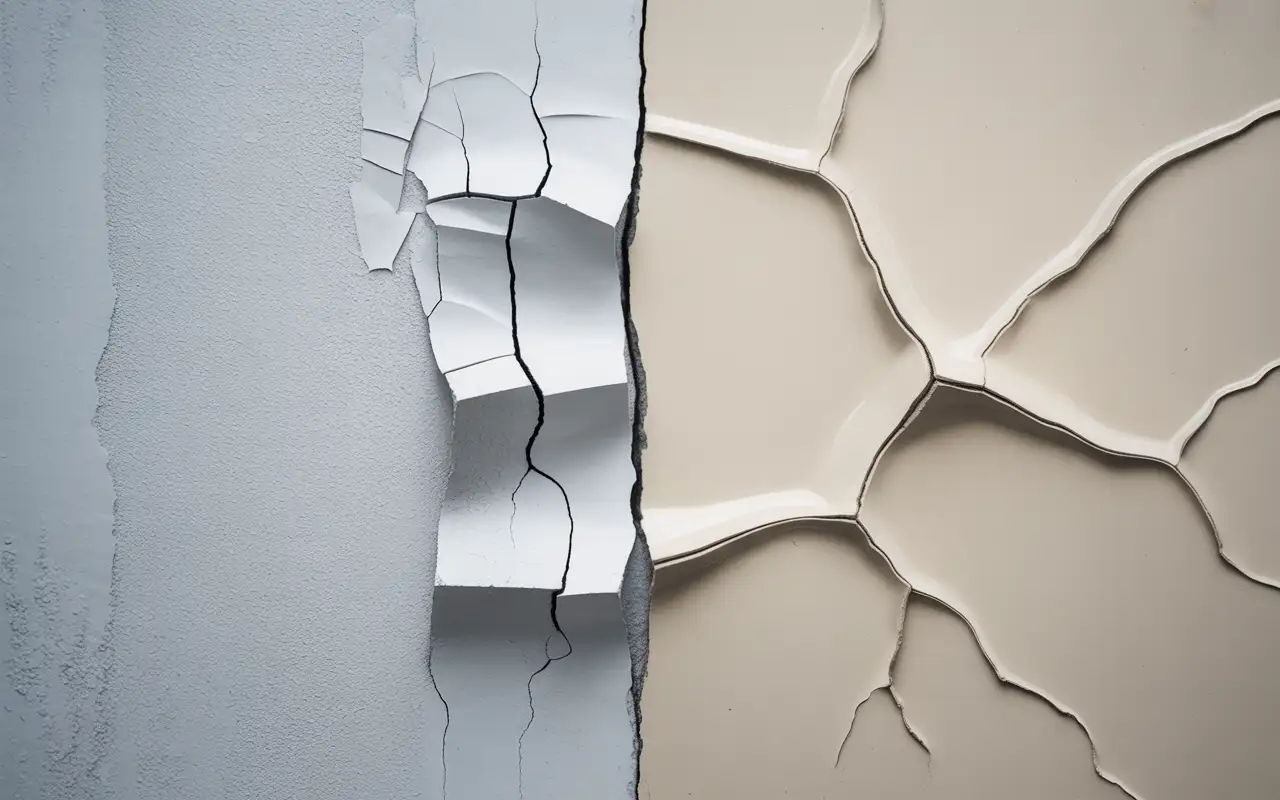Vinyl siding is the main outside material in more than thirty percent of American houses. Many homeowners ask: Can you paint vinyl siding to give it a fresh look? Yes, you certainly can paint vinyl siding if done using the right materials and methods. Save 60–80% compared to full siding replacement and significantly boost the curb attractiveness of your house using this tried-and-true method.
Painting Vinyl Siding: Key Considerations

Technical Feasibility Assessment
Vinyl siding consists of polyvinyl chloride (PVC) polymers that form an impervious surface. Modern paint technology has developed formulations that adhere chemically to vinyl rather than mechanically, making painting it not just possible but highly successful when proper techniques are utilized.
Table of Contents
ToggleManufacturer warranties usually become invalid once you paint over an original finish, such as vinyl siding that comes with 20-30 year warranties to cover fading and chalking. You should evaluate this loss against the immediate benefits and cost savings associated with painting.
Temperature and weather both play an essential part in painting success. Avoid painting when temperatures exceed 80degF or drop below 50°F to avoid vinyl expansion that leads to paint failure, and cold weather prevents proper curing and adhesion.
Vinyl siding that’s older than 15-20 years may have become brittle or degraded over time, preventing paint from adhering properly and cracking during its expansion-contraction cycles. Before painting large areas of siding, experiment in one hidden corner first to test for flexibility.
Pre-Painting Evaluation Checklist
Start by performing a comprehensive surface condition analysis. Walk around your entire home looking for loose panels, cracks, warping or areas where caulking has failed and document these issues before beginning the painting project.
Color restrictions are integral to achieving success when painting vinyl siding, so only use lighter hues than the current shade when choosing new hues for painting vinyl siding. Darker colors absorb more heat, causing excessive expansion that leads to warping and buckling of siding panels – this rule cannot be waived when painting vinyl siding!
Unsecured panels will cause problems during pressure washing and painting; to address structural issues first.
Scan the surface for mold, mildew and oxidation as these contaminants prevent proper paint adhesion. Any green or black stains indicate biological growth that must be addressed before painting.
When not to paint vinyl siding
Major damage makes painting impractical. Cracked, warped or loose panels indicate the siding has reached the end of its useful life, and painting won’t solve structural issues.
Perform a cost-benefit analysis before making your decision. If replacement costs only 2-3 times more than painting and your current siding has reached its end of its lifecycle, replacement could provide superior long-term value.
Think carefully about your timeline before embarking on vinyl siding painting, as a full job typically takes between 5-7 days to complete, including preparation, weather delays and drying times between coats.
Choosing the Right Paint for Vinyl Siding
Paint Type Specifications
Acrylic latex paints are the gold standard when it comes to painting vinyl siding, thanks to their water-based formulations that offer superior adhesion, flexibility and durability compared to their oil-based alternatives. Furthermore, acrylic resins create strong bonds with vinyl surfaces while still remaining flexible during temperature fluctuations.
Pure acrylic formulations outshone acrylic-latex blends significantly. Pure acrylic paints were found to resist fading, chalking and cracking better than their blended counterparts and also maintain color integrity for longer under UV radiation exposure.
Urethane-modified acrylics deliver exceptional performance for demanding applications. Combining acrylic flexibility with urethane durability, these paints produce long-term finishes on vinyl surfaces for ultimate wearability.
Essential Paint Properties
Adhesion properties of paints can determine their long-term success, so to achieve long-term success, look for ones specifically labeled for vinyl or plastic surfaces that include adhesion promoters that form chemical bonds with PVC surfaces.
Flexibility ratings ensure the paint flexes with vinyl siding as temperatures change, expanding and contracting significantly over time. Rigid paints may crack under this strain.
UV resistance helps avoid fading and color degradation, with quality exterior paint for vinyl siding typically including UV stabilizers to protect both it and its underlying vinyl from sun damage.
Breathability allows moisture vapor to escape while keeping liquid water at bay, helping prevent an excess of moisture that could otherwise build up and lead to paint blistering and adhesion failure.
Brand Recommendations and Performance Data
Benjamin Moore offers several great choices when it comes to vinyl siding paint, such as Regal Select Exterior and Ben Exterior lines that provide proven vinyl compatibility and long-term durability.
Sherwin-Williams Duration Exterior and SuperPaint Exterior deliver professional-grade performance for painting vinyl cladding projects. These paints consistently rank highly in independent durability testing.
Mid-range options to consider for residential applications include Behr Premium Plus Ultra and PPG Break-Through! Both offer good value while meeting performance expectations for most applications.
Primers for Vinyl Siding
Modern paints designed specifically for vinyl siding typically don’t require primer when painting over properly prepared surfaces, although bonding primers may become necessary when covering glossy or chalky surfaces or making significant color changes.
When primer is required, choose products specifically formulated as adhesion promoters to form a strong connection between the vinyl surface and the topcoat. These adhesive promoters create an effective adhesive surface-topcoat bond.
Apply primer in thin, even coats following the manufacturer’s specifications for optimal curing before adding the finish coat.
How Much Does It Cost to Paint Vinyl Siding?
Professional Service Pricing
Professional painting services typically charge $3-7 per square foot to paint siding projects on residential properties, and an 1,500 sqft home may range anywhere between $4,500 to $10,500 depending on its complexity and regional labor rates.
Regional price differences reflect labor costs and market conditions in each location, with urban regions often costing 20-40% more than rural regions; West Coast markets typically feature the highest pricing structures.
Project size can have an enormous impact on per-square-foot costs. Homes of larger scale tend to enjoy greater economies of scale while smaller projects incur higher setup and mobilization expenses that increase per-square-foot costs relative to larger ones.
DIY Cost Breakdown for an Average Home
Material costs associated with DIY projects typically range between $800-2,500 for an average home. This covers paint for vinyl siding, primers (if needed), brushes, rollers and basic supplies.
Tool rental expenses range between $200-600 depending on equipment needs. Pressure washer rentals range from $30-50 daily while paint sprayer rentals may run upwards of $80-90 daily.
Time investment typically ranges between 40-60 hours for single-story homes; multi-story houses or those featuring complex architectural details could double this estimate.
Cost Comparison Analysis
Painting vinyl siding typically costs 60-80% less than replacement over 10 years. Full siding replacement typically averages $12,000-25,000 while professional quality paint jobs cost between $3,000-8,000.
Home value impact depends on market conditions and execution quality; professional paint jobs typically add 70-80% of project costs to home value while DIY projects may contribute 50-60% depending on quality.
Best Colors for Painting Vinyl Siding
Color Science for Vinyl
Light Reflectance Value (LRV) determines heat absorption and expansion risk. Choose colors with LRV ratings of 55 or higher to prevent excessive heat buildup. This technical requirement protects your investment from thermal damage.
Thermal expansion management requires careful color selection. Dark vinyl siding paint colors absorb more heat, causing greater expansion that can lead to warping, buckling, and paint failure.
Industry standards recommend minimum LRV values of 55 for most climates and 60+ for extreme heat regions. These guidelines ensure long-term success when you repaint vinyl siding.
Trending Color Palettes
Popular exterior paint colors for 2024-2025 include warm whites, soft grays, and muted earth tones. These vinyl siding paint colors offer broad appeal while meeting LRV requirements.
Classic options like colonial white, antique ivory, and light gray provide timeless appeal with proven resale value. These colors work well across different architectural styles and regional preferences.
Two-tone combinations using trim colors create visual interest without violating heat absorption limits. Consider pairing light body colors with slightly darker trim for definition.
Color Selection Strategy
Match your architectural style when selecting siding paint colors. Traditional homes look best in classic palettes, while contemporary designs can handle more adventurous choices within LRV limits.
Consider your landscape and natural surroundings. Colors should complement rather than compete with established plantings and hardscape elements.
Research neighborhood trends and HOA requirements before finalizing color choices. Some communities have restrictions on acceptable color ranges.
How to Paint Vinyl Siding: Step-by-Step Process

Phase 1: Preparation and Planning
Begin with systematic damage evaluation. Document any loose panels, cracks, or areas needing caulk repair. Address structural issues before proceeding with surface preparation.
Minor repairs include filling small cracks with appropriate caulk and securing loose panels. Use color-matched caulk for visible seams and joints.
Pressure wash the entire surface using 1,500-2,500 PSI with a 25-40 degree nozzle. Work from top to bottom, maintaining consistent distance to avoid damage. Allow 48-72 hours for complete drying.
Clean heavily soiled areas with mildew-killing solution before pressure washing. This biological treatment prevents regrowth under the new paint film.
Phase 2: Material Preparation
Confirm final color selection with test patches in different lighting conditions. Colors can appear dramatically different in morning versus afternoon light.
Calculate paint quantities allowing for 10-15% waste factor. Most exterior paint for vinyl siding covers 350-400 square feet per gallon on properly prepared surfaces.
Set up spray equipment according to manufacturer specifications. Proper calibration ensures even coverage and eliminates common application problems.
Phase 3: Application Process
Apply primer only when surface conditions require it. Follow manufacturer’s recoat windows carefully to ensure proper adhesion between coats.
Begin first coat application during optimal weather conditions. Temperature should be between 50-80°F with low humidity and minimal wind.
Use systematic coverage patterns to maintain wet edges and prevent lap marks. Work in manageable sections that can be completed without interruption.
Apply the second coat within the manufacturer’s specified recoat window. This timing ensures proper chemical bonding between coats for maximum durability.
Phase 4: Finishing and Cleanup
Complete all trim and detail work with appropriate brushes for precision. These areas often require hand application for professional results.
Conduct thorough final inspection looking for thin spots, missed areas, or application defects. Address any issues while equipment is still set up.
Establish a maintenance schedule including annual washing and inspection. Proper maintenance extends paint life significantly and protects your investment.
Conclusion
Painting vinyl siding is a cost-effective way to update your home’s look without replacing it. With the right prep, paint choice, and timing, you can make your siding look like new. In sunny areas like San Diego, using vinyl safe paint helps prevent warping and fading. If you want a professional finish, San Diego Custom Painting offers expert interior painting services and exterior painting services in San Diego that include siding painting for lasting results.
FAQs
Is painting vinyl siding a good idea?
Yes, painting vinyl siding is an excellent choice when your siding is structurally sound but showing signs of fading or color changes. This approach works best on homes 10-25 years old where the vinyl remains flexible and well-attached. You’ll save 60-80% compared to replacement while achieving dramatic appearance improvements.
Ideal circumstances include faded but intact siding, desire for color change within LRV limits, and budget constraints that make replacement impractical. However, consider that painting voids manufacturer warranties and requires maintenance every 10-15 years.
What kind of paint will stick to vinyl siding?
100% acrylic latex paint formulated for vinyl surfaces provides the best adhesion and longevity. These specialized formulations include adhesion promoters that chemically bond with PVC polymers. Brands like Benjamin Moore, Sherwin-Williams, and Behr offer proven vinyl-safe paint options.
The paint must be flexible enough to handle thermal expansion while maintaining strong adhesion. Look for products specifically labeled as suitable for vinyl or plastic siding to ensure compatibility and performance.
How long will a paint job last on vinyl siding?
Professional-quality paint jobs on vinyl siding typically last 10-15 years with proper maintenance. Factors affecting longevity include paint quality, surface preparation, application technique, climate conditions, and color choice.
Premium acrylic paints in lighter colors perform best, often reaching the 15-year mark. Budget paints or darker colors may require refresh in 7-10 years. Regular cleaning and prompt touch-ups extend paint life significantly.
Is it cheaper to paint or replace vinyl siding?
Painting costs 60-80% less than replacement in most cases. Typical painting projects cost $3,000-8,000 while replacement runs $12,000-25,000 for average homes. The break-even point usually occurs when painting costs exceed 40% of replacement costs.
Consider the age and condition of existing siding. If your siding is over 20 years old with structural issues, replacement might offer better long-term value despite higher upfront costs.
Will vinyl siding buckle if painted?
Vinyl siding can buckle if painted with dark colors that absorb excessive heat. This thermal expansion exceeds the material’s flexibility limits, causing permanent warping. Prevent buckling by choosing colors with Light Reflectance Values (LRV) of 55 or higher.
Proper color selection and quality paint application eliminate buckling risks. Light colors reflect heat effectively while maintaining the vinyl’s structural integrity. Always test color choices in small areas before committing to full application.





